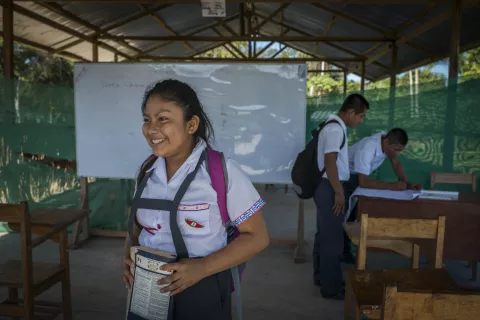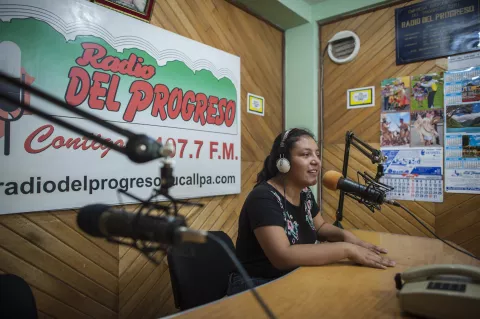Adolescents: Leaders and presidential advisors

Lima, October 5, 2016.- “I want a social revolution for my country,” said the President of Peru, Pedro Pablo Kuczynski, upon taking office. A few days ago, he made a revolutionary move in a country where many adults still believe children should be seen and not heard.
The President, along with Prime Minister Fernando Zavala and the Minister of Women and Vulnerable Populations, Ana María Romero, participated in the first of a series of meetings they plan to have with Children’s Advisory Councils across the country. At the meeting in Lima, Peru’s capital, they engaged with 16 children from diverse backgrounds. UNICEF also participated and worked with the children beforehand to gather their opinions.
“Since I was eight, I dreamed of speaking with people in power to tell them to make changes for children and adolescents, invest in our education and help us,” said Brahyan Ccoyllo Aguilar, a seventeen-year-old who travelled eight hours to Lima from the Andean town of Huamanga, in Peru’s Ayacucho region.
Patricia Lindo Mendoza also came from Huamanga. She is a high school senior who told us that, based on her experience, policies need to be implemented to make real change. As she boarded the bus to the Presidential Palace, she had a clear message: “I am going to tell the President and the Ministers to not only create these programmes, but also make them happen. In Ayacucho we have two hours of schooling devoted to vocational orientation, but we don’t have teachers to deliver them. So we have two free hours wasted when we could really use that time to help us make decisions about our careers.”
Like Brahyan and Patricia, Luis Enrique Alomia Fernández was excited about the meeting. “I like that the meeting is private, without the press, so we can share our concerns and give recommendations to the President and the Ministers.” Even though Luis Enrique is turning eighteen, and will soon leave his post as a child representative, he plans to continue working for children in the future. He has already started his first year at the National University of San Marcos in Lima, majoring in Political Science.
We asked the three youth about the biggest problem facing Peruvian children. They all agreed that it is violence – in all its forms at school, at home, in the community and in the media. During the meeting, they were thrilled to hear from Minister Romero about the launch of a national campaign against violence. The campaign slogan is: “No more hitting or humiliation, it is time for a change.”
The meeting took place at the Presidential Palace and at first the children seemed nervous to speak with “the most powerful adults in the country.” But the President quickly broke the ice, telling the children he expected to have more fun talking with them compared to his regular cabinet meetings.
“One of the seven pillars of my government is to listen to the people,” said the President, “and so I am here to listen to you.” He listened attentively to the children’s diverse requests and recommendations, including Brahyan’s remark on violence and how it can turn into a vicious cycle. “Our parents lived through this violence, years ago, and now they repeat it. I have also been a victim of their violence and I know better to educate with kindness and compassion,” he said. The adults present recalled that his region, Ayacucho, was the most affected by Peru’s armed conflict in the 1980s and 1990s.
Olga Isaza, UNICEF Deputy Representative in Peru, also attended the meeting. Building on the children’s remarks, she noted that while public investment in children has increased steadily in Peru, only 0.9 per cent of this investment is allocated to address violence. She also highlighted the important role of the councils in giving Peruvian children a space for participation and citizenship-building.
The councils are supported by the Ministry of Women and Vulnerable Populations. They aim to create opportunities for children to participate in policy decisions that directly affect them, in line with the 2012-2021 National Action Plan for Children and Adolescents. The councils demonstrate the Government’s commitment to guarantee children the right to participation and promote their protection and development.
There are currently 180 Children’s Advisory Councils in Peru: 12 regional, 38 provincial and 130 at the district level. One of the councils has national representation.
UNICEF, working with the Ministry of Women and Vulnerable Populations and the Prime Minister’s office, organized this first consultation and will support the next meetings between President Kuczynski and the regional councils. Maria Luisa Fornara, UNICEF Representative, confirmed that the UN agency will continue to promote children and adolescent participation in these meetings and assist in their coordination. Six months from now, the President and his Ministers will continue the conversation with more child representatives around the country.
Photo Credits: PCM
Media contacts
About UNICEF
UNICEF promotes the rights and wellbeing of every child, in everything we do. Together with our partners, we work in 190 countries and territories to translate that commitment into practical action, focusing special effort on reaching the most vulnerable and excluded children, to the benefit of all children, everywhere.
For more information about UNICEF and its work for children, visit www.unicef.org/peru.
Follow UNICEF on Sigue las noticias de UNICEF en Instagram, Twitter, LinkedIn, Facebook and YouTube




